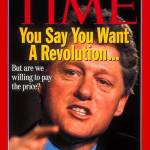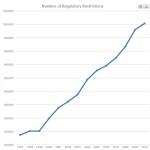In 1998, President Bill Clinton announced: “We have moved past the sterile debate between those who say Government is the problem and those who say Government is the solution.  My fellow Americans, we have found a Third Way.”[1]
My fellow Americans, we have found a Third Way.”[1]
Third Way politics became popular in the 1990s after the final collapse of the Soviet Union. Socialists were feeling chastened and adrift, and middle-of-the-roaders were uncomfortable with moving further towards free-market capitalism. The fall of the Soviet Union was an indictment of socialism, but what exactly was the lesson? Two positions emerged.
1. Socialism has failed, so free markets are the future.
2. A certain kind of socialism has failed, but we should now blend the strengths of the private sector with the virtues of government management.
Position 2 prevailed among leading academic and public intellectuals and politicians. UK Prime Minister Tony Blair joined Clinton’s call: “The Third Way stands for a modernized social democracy … it is a third way because it moves decisively beyond an Old Left preoccupied by state control, high taxation and producer interests; and a New Right treating public investment, and often the very notions of ‘society’ and collective endeavour, as evils to be undone.”[1]
The mixed economy would be adopted, not merely as a de facto result of faction politicking, but as the guiding ideology of a new era.
In the USA, the Third Way meant co-management of the economy along these lines:
 * The Federal Reserve and Wall Street will jointly direct financial policy.
* The Federal Reserve and Wall Street will jointly direct financial policy.
* Fannie Mae, Freddie Mac and the real estate industry will work out housing.
* The Department of Transportation and the major automotive and airline companies will manage the transportation sector.
* The Department of Energy and the energy corporations will cooperate on energy policy in oil, gas, and renewables.
* And so on.
By their fruits shall ye know them.
In the decade that followed Clinton’s announcement, regulation of business accelerated and the USA was rocked by financial crises, ethics scandals, and dog-eat-dog fights over who would get bailouts. “Crony capitalism” became the new favorite epithet. Every major player was an enthusiastic practitioner of the Third Way. Countrywide was politically connected. Enron dined regularly on government-business partnerships and actively sought more. The corporations that received huge bailouts, loan guarantees, and subsidies — Citibank, Goldman Sachs, General Motors, Solyndra, etc. — had all played ball.
“Crony capitalism” became the new favorite epithet. Every major player was an enthusiastic practitioner of the Third Way. Countrywide was politically connected. Enron dined regularly on government-business partnerships and actively sought more. The corporations that received huge bailouts, loan guarantees, and subsidies — Citibank, Goldman Sachs, General Motors, Solyndra, etc. — had all played ball.
The lesson? Socialism has failed, the mixed economy has failed, and once again two positions have emerged:
1. Maybe we should try free-market capitalism.
2. This generation’s bad politicians and businessmen have corrupted the beautiful ideal of government-business partnership, but we will get it right the next time.
Stay tuned for a re-publication of this post with the names changed in ten years.
Sources:
[1] The Clinton and Blair quotations are taken from Flavio Romano’s Clinton and Blair: The Political Economy of the Third Way (Routledge, 2006), p. 3.
[2] The regulation graph image is from the invaluable new RegData site, which quantifies regulation data and enables one to display it graphically as one wishes.
“My fellow Americans, we have found a Third Way: we will only deprive you of half your freedom.”
Spot on Dr. Hicks, as always!
Just wondering if you are following the incessantly obscure neologisms and freakenomic gibberish with post-modernist flavorings put forward in the Chronicle Of Higher Education and the Economist, etc. by the likes of David Harvey and the French Thomas Piketty (new darling of the Third Way), not to mention the Pope’s call for “Legitimate Redistribution of Wealth”. Looking forward to your updates on this new left campaign to substitute freedom with so-called “social equality”. Thank you.